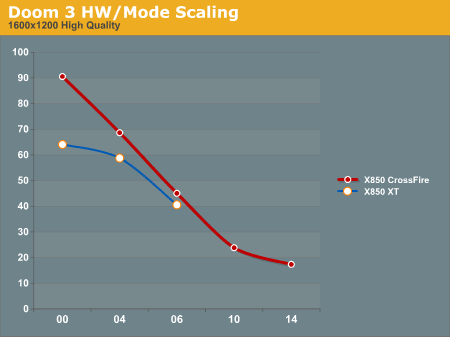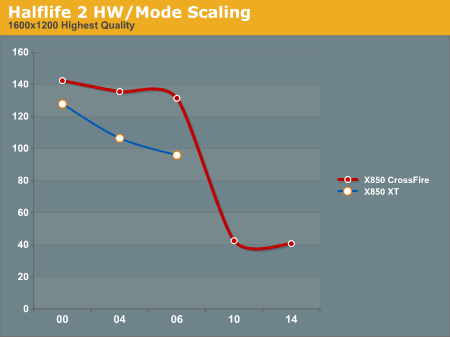ATI's X8xx CrossFire Graphics Arrive
by Derek Wilson on September 26, 2005 1:00 PM EST- Posted in
- GPUs
Mode and Hardware Scaling
There are two scaling factors we want to pay attention to here. First, we will be looking at how CrossFire scales with AA mode. As 8x and 10x share the same performance numbers (as do 12x and 14x), we will be looking at: no AA, 4xAA, 6xAA, 10xAA, 12xAA modes. We will be able to see just how steeply Super AA modes drop off in this test.We will also be looking at single card performance. It will be important to compare these numbers to the Super AA numbers, as each card in Crossfire mode should ideally be able to render the entire scene at single card speeds. Any difference between the Super AA modes and a single card running at either 4x or 6x AA account for the overhead of the communication system and compositing engine. The performance drop in these modes is more pronounced than in the other modes, as each card needs to render the entire scene at full frame rate. Any latency or bandwidth limitations will show up more easily here.
Our graphs show frames per second on the y-axis and AA mode across the x-axis.

Doom 3 shows a good performance increase due to CrossFire at standard AA settings. Both the single card and CrossFire setup are similarly GPU limited as AA increases. The drop from 4xAA on a single card to 10xAA on CrossFire is nearly 50%.
When we take a look at Half-Life 2, we see that a single card is fairly GPU limited with increasing AA while CrossFire handles it well. Going from single card AA modes to CrossFire Super AA modes shows more than a 50% drop in performance. This is likely due to the fact that as framerate increases, the impact of latency and bandwidth restrictions on transferring fully antialiased scenes from the slave to the master is proportionally greater.

Here's a look at how going from a single to a two card configuration scales under NVIDIA and ATI hardware under the games we tested.
| Multi GPU % Performance Improvement (16x12 noAA) | |||
| Doom 3 | Battlefield 2 | Half-Life 2 | |
| CrossFire | 41.3 | 53.8 | 15.8 |
| SLI | 34.0 | 89.3 | 22.2 |
| Multi GPU % Performance Improvement (16x12 4xAA) | |||
| Doom 3 | Battlefield 2 | Half-Life 2 | |
| CrossFire | 69.2 | 63.6 | 35.5 |
| SLI | 81.3 | 89.3 | 68.8 |
While Crossfire performs reasonably well without AA, the 4xAA modes show that SLI provides better scaling. More importantly, though, the lack of support for higher resolutions - as well as 1600x1200 at higher refresh rates - becomes a serious limitation of Crossfire. 7800 GTX SLI running at 2048x1536 has no competition from any ATI configuration for the time being.










76 Comments
View All Comments
justly - Tuesday, September 27, 2005 - link
I’m still a little confused about this 60MHz limit at 1600x 1200.Can someone please explain what I am looking at (in the graphs) when every 1600x1200 resolution that is tested is above 60MHz. If crossfire really is limited to 1600x1200@60MHz then what do these numbers represent? Wouldn’t this also make the entire benchmarking section of this article pointless?
Pete - Wednesday, September 28, 2005 - link
Framerate is separate from the physical refresh (or redraw, in the case of LCDs) rate of your monitor. The cards can produce higher than 60fps at 16x12, but you'll only see at most 60 of those frames in a given second. It's the same principle as with single cards today. Your frame rate might be 120fps, but if you're monitor's refreshing at 85Hz, you aren't going to see all those frames. They're just--for lack of a better term--thrown away.justly - Wednesday, September 28, 2005 - link
Thanks Pete, but I do understand the difference between a cards frame rate and a monitors refresh rate.My confusion is in regards to this quote from the article “The problem is that ATI is currently fixing maximum CrossFire resolution to 1600x1200@60Hz”, and then we see every game test ran at 1600x1200 over 60Hz (BTW thanks for ignoring my typo of MHz instead of Hz in my earlier post).
If the numbers in the game tests are the actual frame rates then why limit the resolution? Furthermore can the cards driver limit the monitors refresh rate? And again looking at the scores why would they want to do this?
I feel as if I am missing a vital piece of the puzzle.
Fluppeteer - Thursday, September 29, 2005 - link
Sorry, now I think *I'm* missing something.Where does it say anything about the games being run at over 60Hz refresh?
The cards manage significantly higher frame rates than 60fps when rendering
the games, but I've not spotted the monitor setup being mentioned *at all*.
Maybe I'm going blind. The graphs just show frame rate - no mention of refresh.
How do you mean "why limit the resolution"? Who's limiting it to what (in this case)?
The driver is responsible for programming the video outputs on the card, and
for reporting the available modes to the Display Properties dialogue. If the
driver won't let you set a higher resolution, then you can't (without using
something like PowerStrip) even if the card could physically do it. So yes,
the driver could limit it. The modes presented are a the result of negotiation
between the monitor and the driver, unless they're manually overridden. ATi's
drivers have been known not to present all the modes the monitor/card can handle
unless persuaded by a registry hack, but I don't think that's what's going on here.
In case of further confusion, it's up to the card to tell the monitor how to refresh
- the card "pushes", the monitor doesn't "pull". Some monitors have an internal
buffer to allow their screens to be updated separately from the frame buffer, and
obviously the refresh rate affects TFTs less than CRTs (a TFT won't fade to black
a fraction of a second after you last updated it), but the rate at which the video
gets from the card's frame buffer to the monitor is determined by the driver's
decision of how to program the card.
As for why ATi(?) would want to do this, I'm sure they don't. In theory Crossfire
should support higher single-link resolutions (at lower refreshes) - 1920x1200 at
50Hz, for example - and I believe it actually does, with the right monitor attached.
However, the X800/X850 series start to run out of performance above 1600x1200, when
their hierarchical Z buffer doesn't fit any more (according to an article on higher
resolution rendering with 7800GTXs; I could be wrong), so 1600x1200 would be a
reasonable limit anyway; also few LCD monitors support more than that without being
widescreened, and many games don't like a wide screen configuration. What you can't
do is exceed the single link bandwidth, so the card isn't psysically capable of
sending 1600x1200 at 85Hz for a CRT. 1600x1200 on an LCD should be fine, because
60Hz won't flicker; it's only CRT owners and those (few) with dual link LCDs who
have a problem.
I would guess this test was performed with a 20" LCD, on the basis that a 60Hz
1600x1200 CRT would drive the reviewer nuts quickly, and they're more common than
1920x1200 panels; hence no test above this. Any specific details of refresh will
presumably be the result of the driver talking to the monitor, and may not correspond
to what you'd get with a *different* monitor. Almost all TFTs will be within the
limits, but if you've got a decent CRT then it's definitely a problem. Nice of ATi
to buy us all 2405FPWs, isn't it?
--
Fluppeteer
FreshPrince - Tuesday, September 27, 2005 - link
even though their overall sli performance is lower than nvidia, if you compare the percentage increase from ati single to sli with the percentage increase from nvidia single to sli...ati comes out on top.which basically tells us when ati comes out with a 7800gtx killer, they will have much higher sli numbers than nvidia.
the limitations, I'm sure they will square out in future implementations of crossfire.
I hope ati comes out with all-in-wonder editions of the sli cards...can you say 2 channels at the same time without any lag? :D
TheInvincibleMustard - Wednesday, September 28, 2005 - link
"ati comes out on top"... umm ... did you read/understand the tables at the bottom of page 6? Quoted directly from the review -- "the 4xAA modes show that SLI provides better scaling" ... meaning that SLI gets closer to the theoretical doubling of performance (ie, 100%) than CrossFire does. In fact, the only situation in which a move from single-card to dual-card scales better on the ATI side than the nVidia side is Doom3 at 16x12/noAA (41.3% vs 34.0%)...
This tells us nothing substantial about performance improvements when ATI comes out with R520, but in my opinion it would seem that nVidia has the stronger dual-card algorithms. If I had the choice of spending an additional $425 (cost of a master card, estimated) for an average performance improvement of ~37% with noAA or ~56% with 4xAA for ATI's CrossFire, versus spending an additional $450 (cost of another 7800GTX) for an average performance improvment of 48.5% with noAA or 79.8% with 4xAA for nVidia's SLI, I think I would definitely go with nVidia's solution, as that additional $500 for another 7800GTX offers more bang-for-buck than for one of ATI's master cards. Combine this with the fact that 7800GTX SLI offers better performance overall anyway, and it's a no-brainer. The situation's a little different if you've already got a 6800Ultra (but then why are you looking at CrossFire?) or an x850xt (but then why are you looking at SLI?), but those situations have no bearing. Simply put, nVidia has hands-down won this "round" of multi-card rendering, even ignoring current availability.
-TIM
PS -- I would be curious what would be possible with two AIW's hooked up in CrossFire ... that could certainly have some interesting situations open up ...
yacoub - Tuesday, September 27, 2005 - link
So that would denote that AA "costs" more on the ATI setup than it does on the NVidia setup, right?
DerekWilson - Tuesday, September 27, 2005 - link
Not necessarily ...The ATI could have performed better because of the way HL2's code runs on ATI hardware allows a higher maximum performance under similar CPU limitation. It could be a driver efficiency issue. It could be a number of things ...
It's too hard to make a statement about anything when we are bouncing hard off of CPU limited performance.
yacoub - Tuesday, September 27, 2005 - link
Please re-word this caption so it makes more sense given the image (six boxes):DerekWilson - Tuesday, September 27, 2005 - link
the commas seperate list items ... I describe 3 columns there and if ATI is the top row, NVIDIA must be the bottom ... 6 boxes ...I'm not sure how to be more clear. If I can get a good suggestion, I'll certainly change the caption.